MARIANI’SVirtual
Gourmet
April 28,
2013
NEWSLETTER
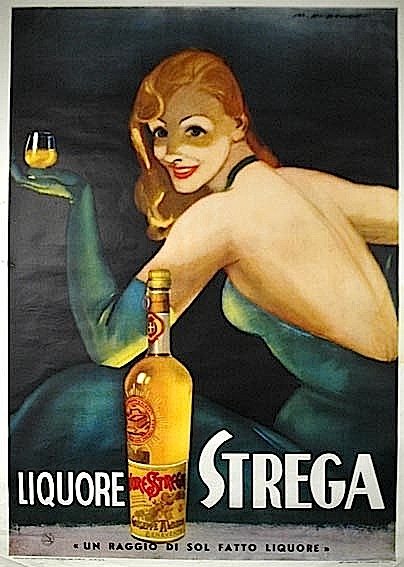
Strega ad, 1930s
THIS
WEEK
NEWPORT, RI
by Robert Mariani
NEW YORK CORNER
The Roger Hotel
by Christopher Mariani
Notes from the Spirits Locker
Deconstructing Bourbon
by Mort Hochstein
❖❖❖
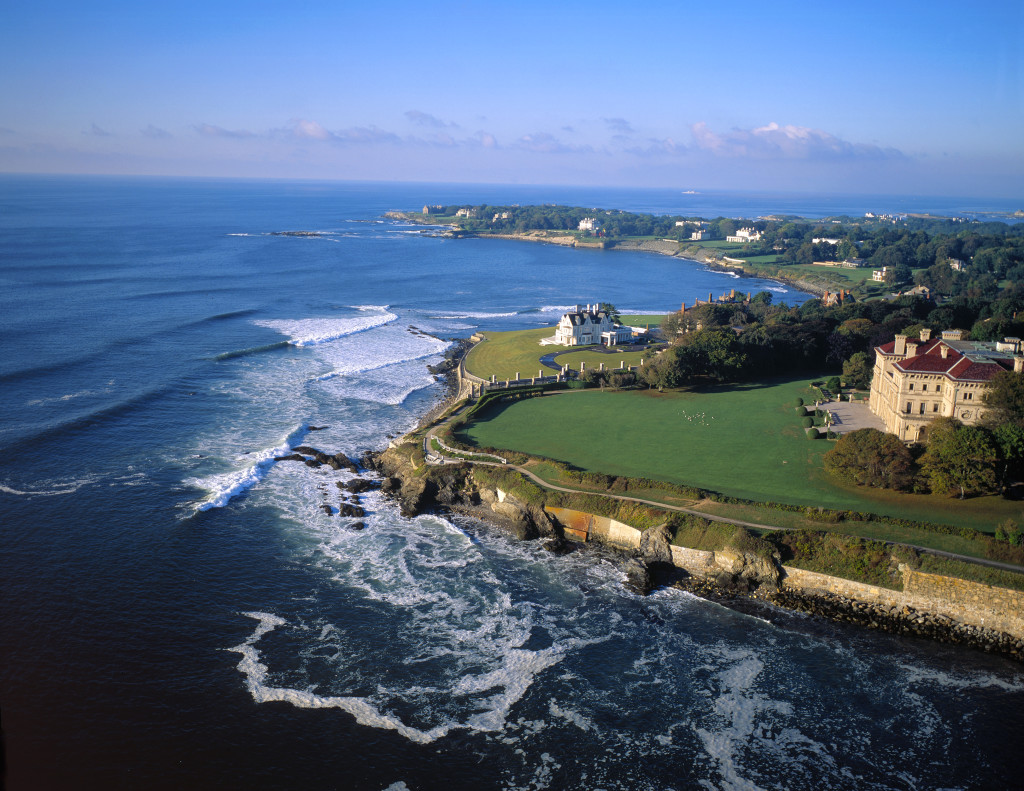
In summer,
people flock to the legendary island city of
Newport, Rhode Island, by
car, by boat, by cruise ships, all to
experience its white
ocean beaches, its yacht races, its mansions
and music festivals. But if you’d rather enjoy
this historic seaside town in a less crowded,
more leisurely way, the best time to visit is
now, before the crowds arrive.
Tours of Newport’s famed
Golden Age mansions begin in Spring when the
stately elm trees along Bellevue Ave. start
spreading their leaves over the lush green lawns
of these “summer cottages, as the “terribly
rich” would describe them. The Vanderbilts’
summer home, The
Breakers, has 70 beautifully decorated
rooms and is the largest of the Newport
mansions. Further down Bellevue, the Château
Sur
Mer is a Victorian masterpiece
overlooking the Atlantic Ocean and is also a
national historic landmark. The
Elms (above
and right)
is modeled after the style of an 18th
century French chateau.
As for dinning in Newport,
there are a number of excellent options.
Here are but three.
 CastleHill
CastleHill
590 Ocean Drive
1-888-466-1355
castlehillinn.com
First
on my list would be The Castle Hill Inn. Newport
has a plethora of spectacular views but the one
from the Castle Hill Inn is to my mind the best
of the best from just about every window. It is
the only Relais et Chateaux establishment in
Rhode Island.
Once the home and laboratory of Victorian
Era marine biologist Alexander Agassiz, the
interior features exquisitely carved wood
paneling, a beautiful dark wood bar, patio
dining when the weather is right, and an
outstanding menu.
The Inn’s three-course Prix
Fixe dinner is $75, $105 with wine pairings. You
cannot do much better for a comfort food starter
on a spring evening than Chef Karsten Hart’s garlic
soup with a brioche garlic toast, poached egg,
and house-made bacon. Another starter, the
Hereford beef tartare, has a seasonal freshness
enhanced by a mix of red onion crostini,
pear, anchovy vinaigrette and Dijon-horseradish
cream.
One of the entrees that keeps
me coming back is the Inn’s sumptuous lobster
risotto with veal sweetbreads, English peas,
oyster mushrooms and a sauce Foyot,
a form of Béarnaise with a meat glaze
added--hard to imagine a more seductive blend of
textures. The roasted rabbit ballotine is
another springtime favorite, with its smoked
carrot, goat's cheese dumpling and rabbit jus. The Inn’s
take on seafood includes a perfectly pan-seared
Atlantic salmon with hearts of palm, roasted
golden beets, dill-dotted pierogi,
and celery mignonette
finished with a freshly made borscht.
(Just a reminder: during the
busy summer months, making reservations days in
advance is advised. And the dress code is casual
but smart.)
Spiced
Pear
The Chanler Inn at the Cliff Walk
401-847-2244
thechanler.com
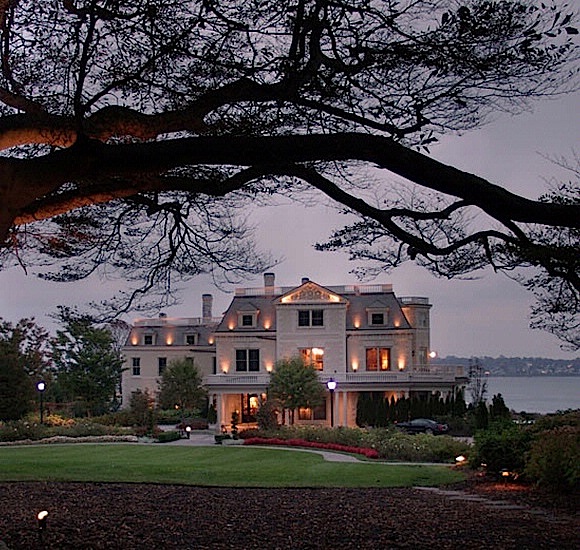 Directly
across the island from Castle Hill, overlooking
Easton’s Beach, The Chanler Inn at the Cliff
Walk presents yet another splendid view of the
ever-changing Atlantic. On the night we dined at
the Chanler’s Spiced Pear, the early April sun
was just setting behind some silver clouds, and
from our table by the window the surface of the
rippling water looked like polished steel. On
any given day, regardless of the season or the
weather, you’re likely to see some of Newport’s
intrepid surfers carving the waves.
Directly
across the island from Castle Hill, overlooking
Easton’s Beach, The Chanler Inn at the Cliff
Walk presents yet another splendid view of the
ever-changing Atlantic. On the night we dined at
the Chanler’s Spiced Pear, the early April sun
was just setting behind some silver clouds, and
from our table by the window the surface of the
rippling water looked like polished steel. On
any given day, regardless of the season or the
weather, you’re likely to see some of Newport’s
intrepid surfers carving the waves.
The Chanler bills itself as a
“European style inn.” It looks and feels like a
Victorian mansion but with spirited touches from
the 21st century, not least their shiny
new open kitchen looking out into dining room. I was
delighted with the Pear’s soup du jour, a
lobster bisque that might well be the best
version of same I’ve tasted, with hints of
sherry and perfectly cooked lobster meat.
Another little culinary jewel
is their mushroom and egg salad with poached
free-range duck egg, Vermont cheddar polenta,
organic mushrooms, asparagus, wild arugula, and
truffle-citrus vinaigrette.
Other starter options were an
organic beet salad with Vermont butter and
cheese, and an ahi tuna carpaccio, all dressed
and garnished for Spring. I was so pleased with
my lobster bisque that for my entrée I
ordered the butter poached lobster. The tail and
body meat were presented neatly carved from the
shell (no bib or nut cracker necessary). It was
accompanied by some bitter broccoli di rabe,
truffled leeks,
pancetta, petite artichokes, candied
beets (a great combination!), plus tomato confit
and a sunchoke puree. Other featured dinner
items include Gulf shrimp and Maine diver’s
scallops with wheat noodles, baby bok choy, and
edamame; British Columbia King salmon; duck
breast with baby winter vegetables and blood
orange juice; and a Hudson Valley hare encrusted
with crispy almonds, and a wild boar
bacon-wrapped loin.
As an Inn The Chanler of course
serves breakfast and lunch too. Entrée prices at The Spiced
Pear range from $32 to $48. There is also a
Chef’s Tasting Menu with six courses for $98
paired with wine; and a nine-course Gourmand
Tasting for $144, and $153 with wines.
The
Black Pearl
Bannister's Wharf
401-846-5264
blackpearlnewport.com
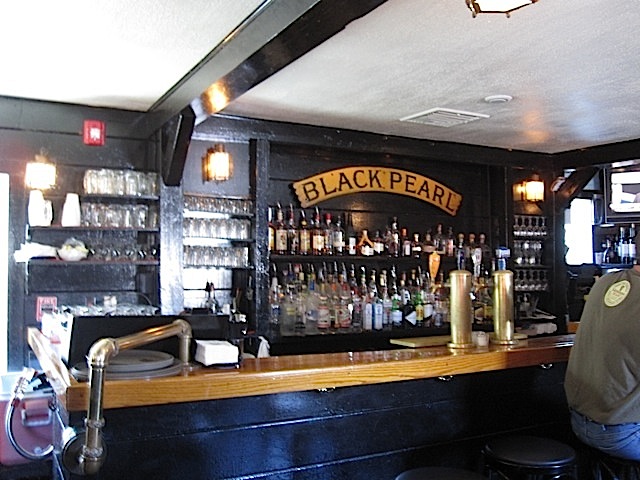 If
you’re looking for great seafood in a less
formal dinning venue, The Black
Pearl is one of Newport’s oldest and most
appreciated restaurants by both locals and
tourists alike.
Located on the docks on bustling
Bannister’s Wharf, the Pearl maintains its
saltwater patina from the 1920’s, when it was
used as a sail loft and machine shop. The
interior is all well-worn dark teak wood and the
floors creak as if you were aboard an
ocean-going vessel. When the
weather warms up, the Pearl unveils its outdoor
patio and raw bar venue with the same menu as
inside The Tavern.
If
you’re looking for great seafood in a less
formal dinning venue, The Black
Pearl is one of Newport’s oldest and most
appreciated restaurants by both locals and
tourists alike.
Located on the docks on bustling
Bannister’s Wharf, the Pearl maintains its
saltwater patina from the 1920’s, when it was
used as a sail loft and machine shop. The
interior is all well-worn dark teak wood and the
floors creak as if you were aboard an
ocean-going vessel. When the
weather warms up, the Pearl unveils its outdoor
patio and raw bar venue with the same menu as
inside The Tavern.
In The Tavern, the Pearl’s
creamy white clam chowder continues to be the
most popular signature dish people keep coming
back for. The rest of The Tavern menu has a full
array of shell fish in just about every possible
iteration, along with just about every basic
type of pub food imaginable, from burgers and
chili to filet minion Béarnaise, veal
parmesan, baked cod, or rack of lamb. They also
do a good job with classics like tuna melt on an
English muffin, as well as several other
sandwiches like their juicy corned beef Reuben.
The choices are daunting, and
though I’ve been dining at the Black Pearl for
years now, I still feel like I haven’t made a
dent in its sprawling list of options. If you’re
lucky, the early spring weather will be warm
enough so
that you may dine out on The Pearl’s
patio, where you can watch the yachts and
dinghies come and go.
Feeling like something
grilled? Few things taste better than The
Pearl’s grilled tuna steak with Dutch pepper
butter or their jumbo shrimp scampi or their
bacon-wrapped scallops. If you have not had
enough creamy, heart-stopping goodness yet, The
Tavern’s dessert menu should take care of that
with treats like Key lime pie, seasonal bread
pudding, chocolate pecan pie with vanilla ice
cream, or the berry Napoléon.
Like the menu itself, The
Tavern’s price range “covers the waterfront”
(pun intended). You can enjoy a pretty
inexpensive meal like clam chowder and a salad,
and a beer for about $25, or just a good
hamburger for $8.50 with your choice of add-ons
for 75 cents 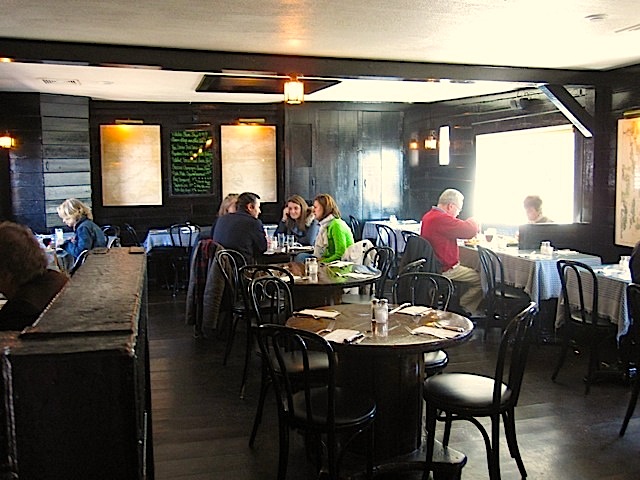 each. At
the bar there’s a large array of beers, ales,
and wines.
each. At
the bar there’s a large array of beers, ales,
and wines.
The
Pearl’s other dining area, The Commodore’s Room,
is separate from The Tavern, with a
more upscale nautical look. Their website
describes this venue as “an elegant dining room
with white-tie ambiance.” Because so many people
travel to Newport by boat, there are no specific
dress codes, but you probably won’t feel very
comfortable here in cut-off jeans and a
sweatshirt. Khakis and a collared shirt are
fine. The Commodore’s Room menu is a paired
down, more formal version of The Tavern’s bill
of fare but with somewhat higher prices. For
starters there’s the Pearl’s signature white
clam chowder and a fine version of lobster
bisque. The appetizer list features dishes like
a shrimp, crab and lobster cocktail with three
sauces; the Chef’s own pâté
de maison; Littleneck clams with Dutch
peppers and bacon; and escargots
bourguignon.
As always, lobster
is at market price and you can have your
two-and-a-half-pounder either grilled or
steamed. For those who prefer a slightly more
delicate entrée, there’s a beautifully
done grey sole panetière.
Or if you’re more in the mood for meat,
there’s Black
Pearl lamb, filet mignon, or veal chop from the
grill.
Both the The Black
Pearl’s Tavern and Commodore’s Room are open
for lunch and dinner seven days a week and
closed from January 3rd to Feb. 12th. Reservations are
not accepted at the outside patio raw bar or
The Tavern. At the Commodore's Room
appetizers run $8-$13, entrees $21-$39; at The
Tavern, appetizers $3-$12, entrees $17-$29.50.
by Christopher Mariani
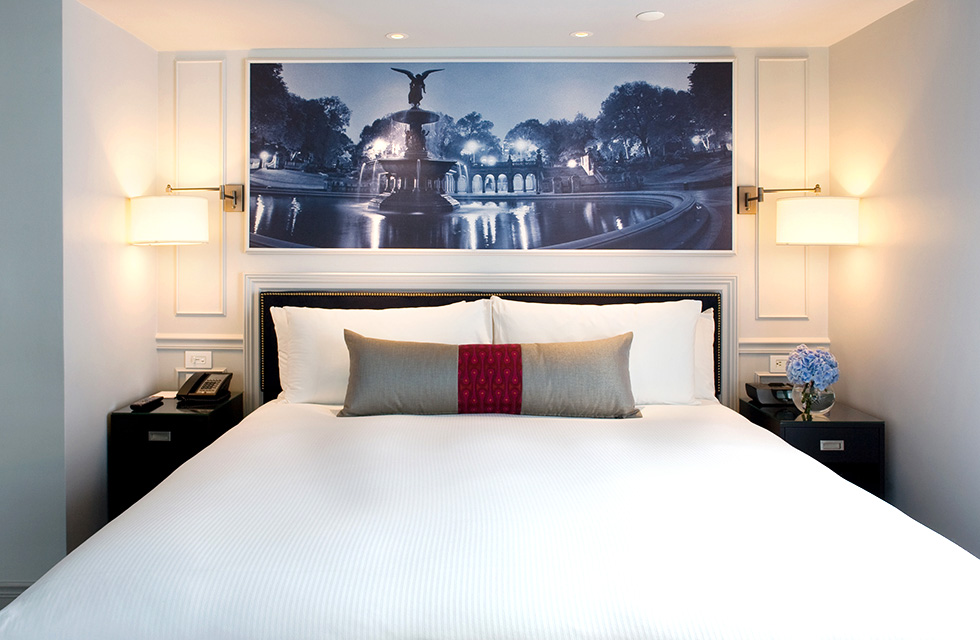 ROGER New
York
ROGER New
York
131 Madison Avenue (at 31st Street)
therogernewyork.com
Manhattan
confidently peacocks its grandeur with truly
awesome architecture, diverse museums,
influential restaurants and an abundance of
impressive hotels. These are just a few of the
extraordinary qualities this unique city has to
offer, so to distinguish oneself in the Big
Apple is no easy task.
A few weeks back, I headed
down to the Flatiron district to check out the
newly renovated Roger Hotel. I entered on
Madison Avenue and was greeted by a friendly
doorman who directed me through a sophisticated
and posh lobby, towards the front desk, there to
be met by a young, female concierge who
cordially welcomed me to the hotel. This
constant, genial quality was evident throughout
the entire property, gratefully noticed during
my two-day stay.
Next stop, my room, on the
ninth floor, overlooking Madison Ave and 32nd
Street. I highly recommend a room on the
northwest corner of the hotel, if available. The view is lovely. Rooms
are decorated in a simple, smart design, trimmed
with a classic molding, and murals of celebrated
NYC locations; our room was hung with an image
of Central Park’s Bethesda Fountain (above).
After a leap onto the bed once the bellhop left
(we all do it, right?), I deemed the
accommodations very, very comfortable.
Madison Ave and 32nd
Street. I highly recommend a room on the
northwest corner of the hotel, if available. The view is lovely. Rooms
are decorated in a simple, smart design, trimmed
with a classic molding, and murals of celebrated
NYC locations; our room was hung with an image
of Central Park’s Bethesda Fountain (above).
After a leap onto the bed once the bellhop left
(we all do it, right?), I deemed the
accommodations very, very comfortable.
Although dinner was nearing,
I needed a light snack. So I ordered a
grilled cheese sandwich made with white cheddar
from Murray's Cheese--the best cheese monger in
the city-- fries, and a glass of Burgundy. The
pre-meal appetizer was a prelude to our
well-executed dinner. Interestingly, the in-room
dining menu is the same as the restaurant’s.
On the mezzanine level,
we exited the elevator directly into The Parlour
(below),
the Roger’s quaint dining option. The
pantry-style dining room looks over a balcony
onto the hotel lobby; an intimate space worth
visiting as a non-hotel guest; great for
cocktails and a few appetizers or a full fledged
meal.
Executive
chef Pete Goldklang has created a
straightforward menu, solid all the way through.
We started with a creamy corn chowder soup,
crispy soda-dipped fried chicken served with a
sweet and spicy honey and hot Sriracha dipping
sauce, accompanied by the hotel’s “Madison
Manhattan” cocktail, made with Bulleit rye
whiskey, Laird‘s apple brandy, sweet vermouth
and bitters. Mentionable salads included the
heirloom tomatoes alla caprese, drizzled with a
sweet, syrupy balsamic reduction. Next, steaming
cavatelli,
coated in a rich pesto sauce, the highlight of
our meal. Whiffs of fresh basil rose from the
plate as the shredded Pecorino Romano, coarsely
chopped pine nuts and silky olive oil blended
together. For entrees, chef 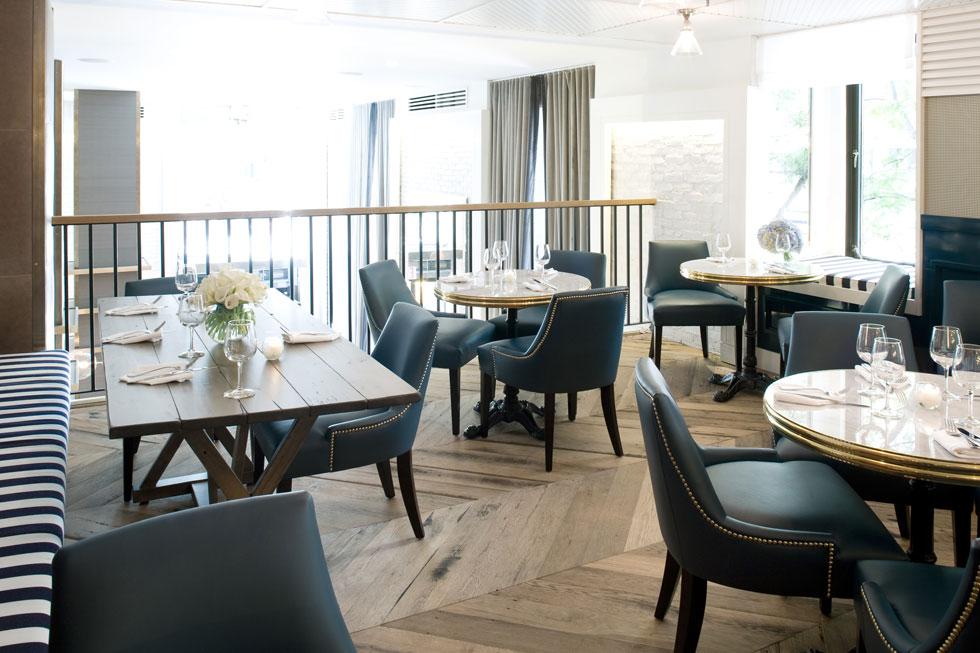 sent out a tender cut of marinated
hanger steak with a bordelaise sauce, and a
silky wild King salmon, cooked medium rare.
Desserts included chocolate molten cake, and the
“Apple Brown Roger,” Gala apples, brandied
brioche and bourbon vanilla bean ice cream. The
Parlour’s wine list could surely use some
bolstering, offering only a handful of red and
white wines; listing just one bottle under $50.
sent out a tender cut of marinated
hanger steak with a bordelaise sauce, and a
silky wild King salmon, cooked medium rare.
Desserts included chocolate molten cake, and the
“Apple Brown Roger,” Gala apples, brandied
brioche and bourbon vanilla bean ice cream. The
Parlour’s wine list could surely use some
bolstering, offering only a handful of red and
white wines; listing just one bottle under $50.
The following morning we
headed back down to The Parlour for their highly
regarded breakfast. The pantry table was
elegantly topped with silver trays of smoked
salmon, delicate pastries, French-style
scrambled eggs, freshly squeezed juices and
richly aromatic coffee.
The remainder of our stay
included a short walk to Madison Square Park’s
Shake Shack for lunch, and, later, dinner at
Midtown East’s Brasserie.
Working only a few blocks from the Roger and
residing in Westchester County, I did not
anticipate such a feeling of respite, as I was
seeing New York as a visitor would and reveling
at the grandness of it all.
❖❖❖
by Mort Hochstein
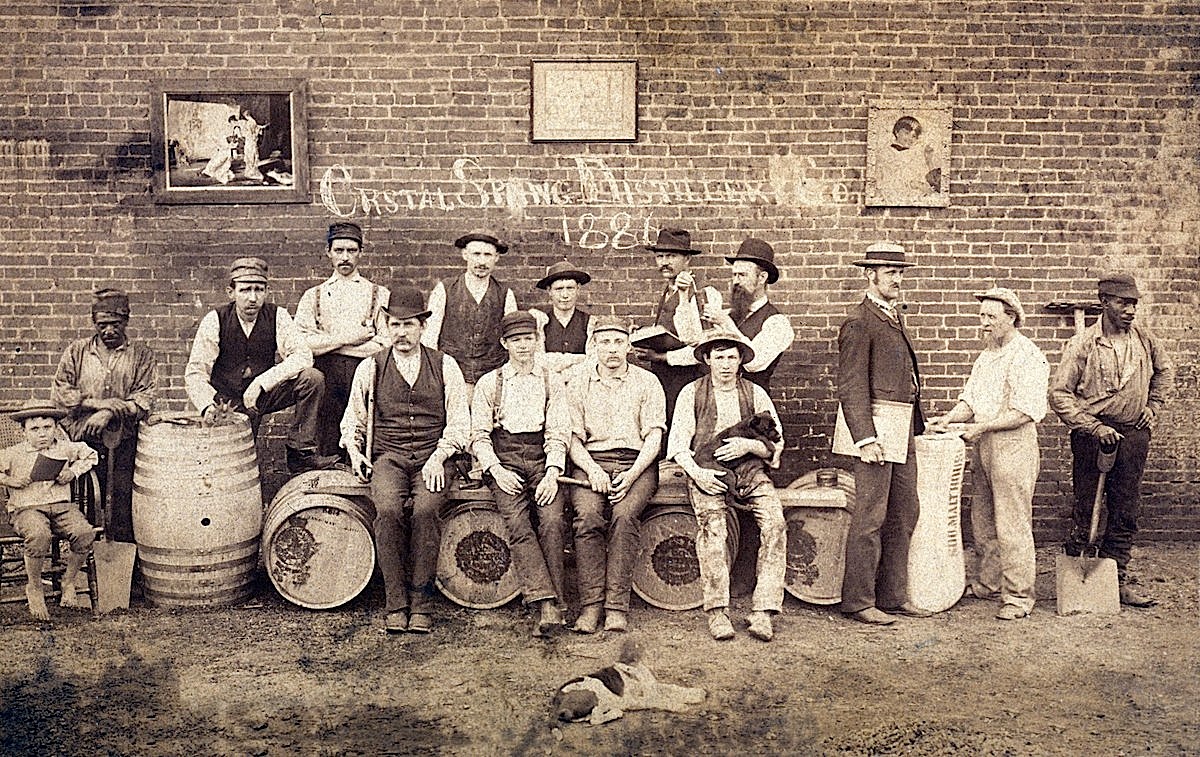
Neighboring rival Tennessee had for many years had just three licensed distilleries. Following a recent loosening of regulations, that number is now 12, with others in the planning stage, though both states had many more distilleries prior to the destruction wrought by Prohibition, And, oddly, an unnamed Tennessee official also said to me “I can’t tell you how many unlicensed.” So there must be a lot of moonshine being brewed in the backwoods of The Volunteer State, as well as across the line in Ole’ Kentucky.
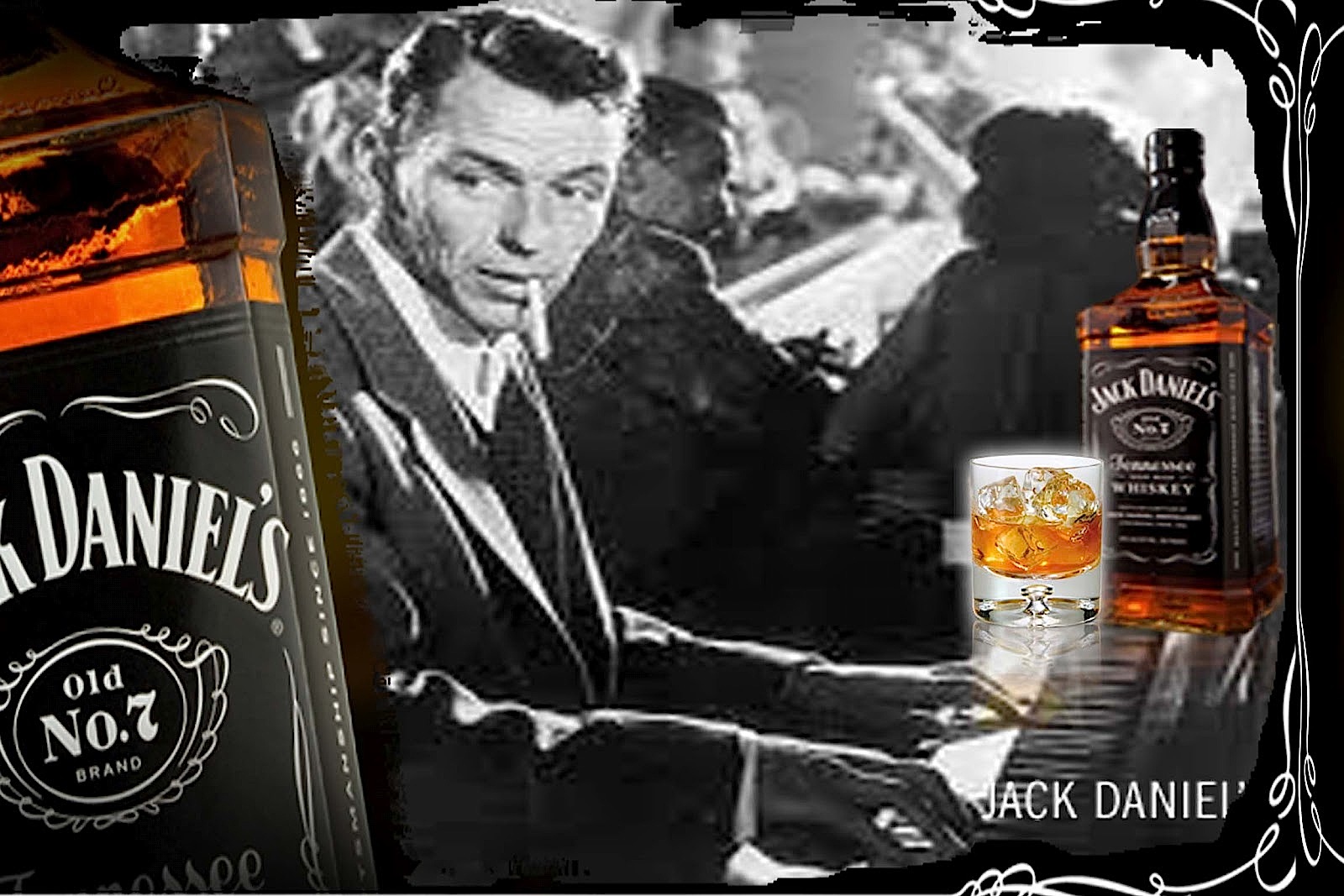
It is interesting to contrast the better known names with the growing number of small producers. Jack Daniel's is the biggest name in its field, and though we may think of it as bourbon, it is classified as a Tennessee whiskey, since producers in Tennessee add an extra filtration through charcoal, a procedure not frequently observed elsewhere.
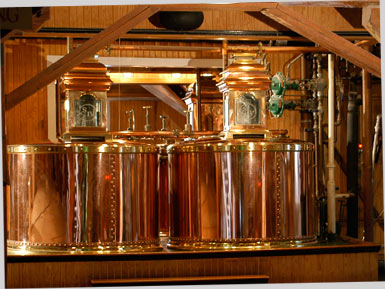 Kentucky is
home to Makers
Mark (left),
Jim Beam, Heaven
Hill, Woodford Reserve and Old Forrester, famous names
in the long history of American spirits.
Kentucky is
home to Makers
Mark (left),
Jim Beam, Heaven
Hill, Woodford Reserve and Old Forrester, famous names
in the long history of American spirits. Tennessee’s best known brand is Jack Daniel’s, revered by Frank Sinatra, whose passion for “Jack” propelled its sales to record levels. The distillery repaid the favor with Sinatra Select, a special bottling honoring that sold out rapidly.
The Jack Daniel’s plant in Lynchburg, Tennessee, is huge, larger than the largest Wal-Mart’s and far taller. The distillery’s website says Jack Daniel’s was founded in 1846, but in the 2004 biography, Blood & Whiskey, the Life and Times of Jack Daniel’s, author Peter Krauss contends that land and deed records show that it was not founded until 1875. Provenance disputes notwithstanding, Jack Daniels’s is the nation’s best known and best selling whiskey. But it is not possible to buy Jack Daniel’s Number 7, its signature label, at the plant because it sits in a dry county. A wrinkle in state law, however, permits a distillery to sell one commemorative product, regardless of local regulations. So Jack Daniel’s now offers Gentleman Jack, Jack Daniel’s’ Single Barrel and a seasonal blend on rotation at the distillery.
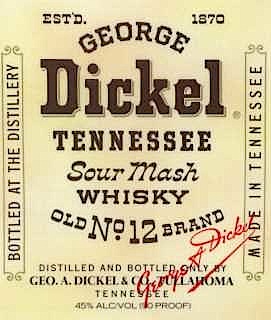 In contrast, George Dickel
in Kentucky, one of the old line
producers in that state, is also one of the smallest.
Its low-lying facility barely makes a dent in the
landscape. In a proud history dating back to 1870,founder
George A. Dickel is credited with the
discovery that whisky formulated in colder seasons
becomes smoother than a spirit produced in the
summer. To
this day, Dickel is the only Tennessee whisky
to chill the spirit before it enters charcoal vats
for mellowing, Dickel is
also credited with causing headaches for writers
and editors who strive for correct spelling of the
terms whisky
and whiskey.
While most American spirits carry the name
"whiskey," Dicker argued that his product was the
equal of the
finest Scotch, and insisted on using the
Scotch spelling
whisky
for his product.
In contrast, George Dickel
in Kentucky, one of the old line
producers in that state, is also one of the smallest.
Its low-lying facility barely makes a dent in the
landscape. In a proud history dating back to 1870,founder
George A. Dickel is credited with the
discovery that whisky formulated in colder seasons
becomes smoother than a spirit produced in the
summer. To
this day, Dickel is the only Tennessee whisky
to chill the spirit before it enters charcoal vats
for mellowing, Dickel is
also credited with causing headaches for writers
and editors who strive for correct spelling of the
terms whisky
and whiskey.
While most American spirits carry the name
"whiskey," Dicker argued that his product was the
equal of the
finest Scotch, and insisted on using the
Scotch spelling
whisky
for his product.In recent years, with the growing number of distilleries, there has been a great focus on locally made, hand-crafted bourbons. Many of today’s entries, produced in small batches with minimal technology involved, proudly claim to be hand-crafted. Jefferson's Bourbon is actually a "collection" of three bourbons (and one rye) made in what the producer, Trey Zoeller, calls "Ridiculously Small Batches,"
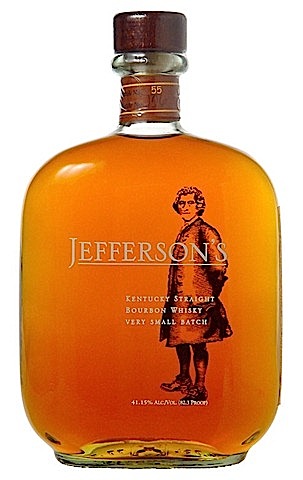 totally
about 300,000 bottles sold per year. The
Reserve is a blend of three different bourbons,
some 20 years old, while another, just named
Jefferson's Kentucky Straight Whiskey, is a
blend of up to 12 different batches of various
ages. This last is a spicy, creamy, tangy
bourbon with a real peppery edge.
totally
about 300,000 bottles sold per year. The
Reserve is a blend of three different bourbons,
some 20 years old, while another, just named
Jefferson's Kentucky Straight Whiskey, is a
blend of up to 12 different batches of various
ages. This last is a spicy, creamy, tangy
bourbon with a real peppery edge. Angel’s Envy, one of the more recent entries, is the latest act for Lincoln Henderson, a pillar of the Bourbon Hall of Fame, who came out of retirement to develop what he describes as the greatest bourbon he ever made. He’s made a few over the decades. In 1983, Henderson developed Early Times Kentucky Whiskey for Brown Forman and later created Gentleman Jack, Early Times Premium, Woodford Reserve and Forrester1870, among the many products that bear his imprint. In 2011, joining with his son, Wes, he reentered the spirits industry to fashion one of today’s most sought after labels, Angel’s Envy.
The name derives from the industry term, angel’s share, ascribed to the spirits lost to evaporation as the whiskey ages. Henderson argues that the angels might have wanted a bigger cut from his superior product, which matures in traditional new American oak barrels for four to six years, and is then finished in port barrels for three to six months. “We’re the only Kentucky distillery doing this and it pays off with an exceptionally smooth and nuanced bourbon, “ Henderson declares proudly, observing that he enjoys the freedom to experiment and call the shots his way. He makes just 600 bottles of Angel’s Envy bourbon each year (he is also releasing a rye this year) and it has become one of the most sought after of bourbons, largely found in fine restaurants. The bourbon and whiskey world covers a wide range of flavors and styles. Each has its own special quality, from the high production facilities of firms such as Jim Beam and Brown Forman and Jack Daniel’s to the smaller houses such as Dickel and the even more limited production of craftsmen like Lincoln Henderson. There is a lot of bourbon to sample, not to mention all that moonshine flowing out of the backwoods of Kentucky and Tennessee.
❖❖❖
 FURTHER PROOF THAT GOD
FURTHER PROOF THAT GOD
WORKS IN MYSTERIOUS,
IF SOMETIMES CHEESY, WAYS
While eating a bag
of Pepperidge Farm goldfish during Holy Week, Patti
Burke (left,
with goldfish) of Melbourne, Florida,
thought she saw a crown and a cross
imprinted on a cracker and, she tweeted,
"when I picked this one up, I knew he was
special." Her pastor then spoke of the fish during
his Sunday sermon, saying "I think it's a sign. I
think it points to, I would hesitate to call it a
miracle, but I think it points to the miracle,
which is Jesus Christ defeated death. And that's
what Easter is all about."

A NICE PLATE OF KFC
Elizabeth Niemi of
Hooksett, NH, called 911 saying
she wanted help in ordering take out
food. When
firefighters arrived at her home she was
arrested for misuse of 911
Any of John Mariani's
books below may be ordered from amazon.com.
 |
My latest book, which just won the prize for best book from International Gourmand, written with Jim Heimann and Steven Heller, Menu Design in America, 1850-1985 (Taschen Books), has just appeared, with nearly 1,000 beautiful, historic, hilarious, sometimes shocking menus dating back to before the Civil War and going through the Gilded Age, the Jazz Age, the Depression, the nightclub era of the 1930s and 1940s, the Space Age era, and the age when menus were a form of advertising in innovative explosions of color and modern design. The book is a chronicle of changing tastes and mores and says as much about America as about its food and drink.
“Luxuriating vicariously in the pleasures of this book. . . you can’t help but become hungry. . .for the food of course, but also for something more: the bygone days of our country’s splendidly rich and complex past. Epicureans of both good food and artful design will do well to make it their coffee table’s main course.”—Chip Kidd, Wall Street Journal.
“[The menus] reflect the amazing craftsmanship that many restaurants applied to their bills of fare, and suggest that today’s restaurateurs could learn a lot from their predecessors.”—Rebecca Marx, The Village Voice. |
"Eating Italian will never be the same after reading John Mariani's entertaining and savory gastronomical history of the cuisine of Italy and how it won over appetites worldwide. . . . This book is such a tasteful narrative that it will literally make you hungry for Italian food and arouse your appetite for gastronomical history."--Don Oldenburg, USA Today. "Italian
restaurants--some good, some glitzy--far
outnumber their French rivals. Many of
these establishments are zestfully described
in How Italian Food Conquered the World, an
entertaining and fact-filled chronicle by
food-and-wine correspondent John F.
Mariani."--Aram Bakshian Jr., Wall Street
Journal.
"Equal parts
history, sociology, gastronomy, and just
plain fun, How Italian Food Conquered the
World tells the captivating and delicious
story of the (let's face it) everybody's
favorite cuisine with clarity, verve and
more than one surprise."--Colman Andrews,
editorial director of The Daily
Meal.com. "A fantastic and fascinating
read, covering everything from the influence
of Venice's spice trade to the impact of
Italian immigrants in America and the
evolution of alta cucina. This book will
serve as a terrific resource to anyone
interested in the real story of Italian
food."--Mary Ann Esposito, host of PBS-TV's
Ciao
Italia. "John Mariani has written the
definitive history of how Italians won their
way into our hearts, minds, and
stomachs. It's a story of pleasure over
pomp and taste over technique."--Danny Meyer,
owner of NYC restaurants Union Square Cafe,
Gotham Bar & Grill, The Modern, and
Maialino.
|
 |
 |
 |
 |
 |
 |
 |
 |
 Everett Potter's Travel Report:
Everett Potter's Travel Report: 
 Eating Las Vegas
is the new on-line site for Virtual Gourmet
contributor John A. Curtas., who since 1995
has been commenting on the Las Vegas food
scene and reviewing restaurants for Nevada
Public Radio. He is also the
restaurant critic for KLAS TV, Channel 8 in
Las Vegas, and his past reviews can be
accessed at KNPR.org.
Click on the logo below to go directly to
his site.
Eating Las Vegas
is the new on-line site for Virtual Gourmet
contributor John A. Curtas., who since 1995
has been commenting on the Las Vegas food
scene and reviewing restaurants for Nevada
Public Radio. He is also the
restaurant critic for KLAS TV, Channel 8 in
Las Vegas, and his past reviews can be
accessed at KNPR.org.
Click on the logo below to go directly to
his site.

Tennis Resorts Online: A Critical Guide to the World's Best Tennis Resorts and Tennis Camps, published by ROGER COX, who has spent more than two decades writing about tennis travel, including a 17-year stretch for Tennis magazine. He has also written for Arthur Frommer's Budget Travel, New York Magazine, Travel & Leisure, Esquire, Money, USTA Magazine, Men's Journal, and The Robb Report. He has authored two books-The World's Best Tennis Vacations (Stephen Greene Press/Viking Penguin, 1990) and The Best Places to Stay in the Rockies (Houghton Mifflin, 1992 & 1994), and the Melbourne (Australia) chapter to the Wall Street Journal Business Guide to Cities of the Pacific Rim (Fodor's Travel Guides, 1991).


MARIANI'S VIRTUAL GOURMET
NEWSLETTER is published weekly. Editor/Publisher: John
Mariani.
Contributing Writers: Christopher Mariani, Robert Mariani,
John A. Curtas, Edward Brivio, Mort Hochstein,
Suzanne Wright, and Brian Freedman. Contributing
Photographers: Galina Stepanoff-Dargery,
Bobby Pirillo. Technical Advisor: Gerry McLoughlin.
© copyright John Mariani 2013
